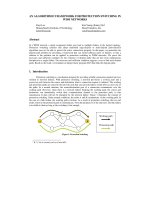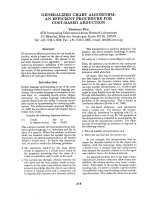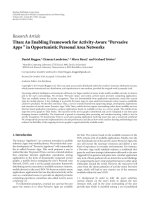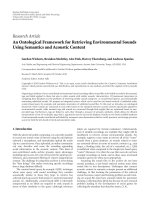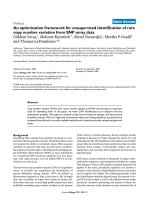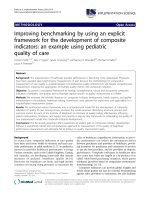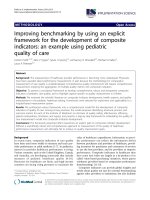An interactive framework for component based morphing
Bạn đang xem bản rút gọn của tài liệu. Xem và tải ngay bản đầy đủ của tài liệu tại đây (2.56 MB, 153 trang )
AN INTERACTIVE FRAMEWORK FOR
COMPONENT-BASED MORPHING
ZHAO YONGHONG
NATIONAL UNIVERSITY OF SINGAPORE
2003
AN INTERACTIVE FRAMEWORK FOR
COMPONENT-BASED MORPHING
ZHAO YONGHONG
(M.Eng., Zhejiang University, China)
A THESIS SUBMITTED
FOR THE DEGREE OF DOTOR OF PHILOSOPHY
DEPARTMENT OF COMPUTER SCIENCE
NATIONAL UNIVERSITY OF SINGAPORE
2003
An Interactive Framework for Component-based Morphing
i
Acknowledgements
First and foremost, I would like to thank my supervisor, A/P Tan Tiow Seng, for
his invaluable guidance in my research. What I have learnt from him is not only how to
actively tackle research difficulties and explore original solutions, but also the research
philosophy, which will benefit me forever.
I would also like to acknowledge my gratitude to A/P Teh Hung Chuan and Dr.
Huang Zhiyong for giving me much encouragement and many suggestions.
I am deeply grateful for the assistance of Mr. Ong Hong Yang, Mr. Xiao
Yongguan and Mr. Li Xuetao. I got much motivation and inspiration from the
collaboration with them.
Finally, I would like to add personal thanks to my husband Ying Peizhi for his
love and to my parents for their endless support.
This thesis is to my lovely son and I wish him a happy and healthy future.
An Interactive Framework for Component-based Morphing
ii
Table of Content
TUAcknowledgementsUT i
TUSummaryUT vii
TUChapter 1UT TUIntroductionUT 1
TU1.1UT TUBackgroundUT 1
TU1.2UT TUObjectivesUT 4
TU1.3UT TUOrganization and ContributionUT 5
TUChapter 2UT TURelated WorkUT 8
TU2.1UT TU2D MorphingUT 8
TU2.2UT TU3D MorphingUT 9
TU2.2.1UT TU3D Volume-based MorphingUT 10
TU2.2.2UT TU3D Boundary-based MorphingUT 12
TUChapter 3UT TUComponent-based Morphing FrameworkUT 20
TU3.1UT TUMeshes and ComponentsUT 20
TU3.1.1UT TUPolygon MeshUT 20
TU3.1.2UT TUComponent DecompositionUT 21
TU3.2UT TUComponent-based Object RepresentationUT 23
TU3.3UT TUFramework OverviewUT 24
TUChapter 4UT TUComponent-based Correspondence ControlUT 28
TU4.1UT TUGlobal-level CorrespondenceUT 28
An Interactive Framework for Component-based Morphing
iii
TU4.1.1UT TURequirement AnalysisUT 29
TU4.1.2UT TUTerminologyUT 30
TU4.1.3UT TUCorrespondence between component groupsUT 33
TU4.1.4UT TUConstraint TreeUT 38
TU4.1.5UT TUCandidate IdentificationUT 43
TU4.1.6UT TUCommon Connectivity Graph ConstructionUT 46
TU4.2UT TULocal-level CorrespondenceUT 51
TU4.2.1UT TUUser-specified Local-level CorrespondenceUT 52
TU4.2.2UT TUImplied Local-level CorrespondenceUT 54
TU4.2.3UT TUAssumed Local-level CorrespondenceUT 58
TU4.2.4UT TUAutomatic Patch PartitioningUT 62
TU4.2.5UT TUPatch ParameterizationUT 67
TU4.2.6UT TUHandling Null-componentsUT 71
TUChapter 5UT TUComponent-based Interpolation ControlUT 77
TU5.1UT TUSkeleton-based Animation/DeformationUT 78
TU5.2UT TUSkeleton RepresentationUT 80
TU5.3UT TUSkeleton MorphingUT 85
TU5.3.1UT TUCommon Skeleton ConstructionUT 86
TU5.3.2UT TUSkeleton TransformationUT 90
TU5.4UT TUSkeleton-guided InterpolationUT 92
TU5.4.1UT TUVertex Binding TechniqueUT 92
TU5.4.2UT TUSingle BindingUT 94
TU5.4.3UT TUDouble BindingUT 97
TU5.4.4UT TUBoundary BlendingUT 99
TU5.5UT TUTrajectory EditingUT 103
An Interactive Framework for Component-based Morphing
iv
TUChapter 6UT TUExperimental ResultsUT 106
TU6.1UT TUGraphical User InterfaceUT 106
TU6.2UT TUDemo of Whole Morphing ProcessUT 110
TU6.3UT TUMorphing Sequences and StatisticsUT 114
TUChapter 7UT TUConclusionUT 124
TU7.1UT TUSummary of FrameworkUT 124
TU7.2UT TUDiscussion of MethodsUT 126
TU7.3UT TUFuture WorkUT 130
TUReferencesUT 133
TUAppendixUT 140
TUInteractive DecompositionUT 140
An Interactive Framework for Component-based Morphing
v
List of Figures
TUFigure 3.1 Component representation of a cow modelUT 23
TUFigure 3.2 A typical workflow in the frameworkUT 25
TUFigure 4.1 The source connectivity graph GUBU
s
UBU and the target connectivity graph GUBU
t
UTB 31
TUFigure 4.2 Common connectivity graph GUBU
st
UTB 32
TUFigure 4.3 Processing constraint and updating UT 37
TUFigure 4.4 Specifying component correspondences using component groupsUT 37
TUFigure 4.5 Constraint TreeUT 39
TUFigure 4.6 Flexible undoingUT 40
TUFigure 4.7 Undoing the first constraint in Figure 4.4UT 41
UTFigure 4.8 Correspondence maintenance after modifying component decompositionT 42U
TU
Figure 4.9 Analysis of similarity in connectivityUT 45
TUFigure 4.10 Identifying candidates for user-selected componentsUT 46
TUFigure 4.11 Similarity measurement of componentsUT 48
TUFigure 4.12 Two kinds of paths connecting two verticesUT 53
TUFigure 4.13 Deduced correspondences over boundariesUT 56
TUFigure 4.14 Deduced correspondences for the null-component caseUT 57
TUFigure 4.15 Assumed feature vertex pairs at feature loopsUT 60
TUFigure 4.16 Assumed feature vertex pair at tipsUT 61
TUFigure 4.17Assumed local feature pair at boundariesUT 62
TUFigure 4.18 Automatic patch partitioningUT 66
TUFigure 4.19 Mapping and Merging of corresponding patchesUT 69
TUFigure 4.20 Topological Merging for meshes T and UUT 70
TUFigure 4.21 Updating boundary trianglesUT 73
TUFigure 4.22 Automatic handling the disappearing of the tailUT 74
TUFigure 4.23 Handling null-component in T-U morphUT 75
An Interactive Framework for Component-based Morphing
vi
TUFigure 5.1 Skeleton representation of a woman modelUT 81
TUFigure 5.2 Bone shapeUT 83
TUFigure 5.3 Bone connectionUT 84
TUFigure 5.4 A moving local frameUT 85
TUFigure 5.5 Meta-skeletonUT 87
TUFigure 5.6 Another example of meta-skeletonUT 89
TUFigure 5.7 Parameters for binding a vertex to a boneUT 94
TUFigure 5.8 Binding a vertex to a meta-boneUT 96
TUFigure 5.9 Fold-over in the interpolationUT 97
TUFigure 5.10 Distribution of blending weightsUT 102
TUFigure 5.11 Morphing two objects with different orientationsUT 103
TUFigure 6.1 Object viewUT 107
TUFigure 6.2 Component viewUT 108
TUFigure 6.3 Frame viewUT 109
TUFigure 6.4 A demo of duck-dinosaur morphUT 110
TUFigure 6.5 A demo of mug-donut morphUT 112
TUFigure 6.6 Global-level trial and error morphing designUT 113
TUFigure 6.7 Local-level trial and error morphing designUT 113
TUFigure 6.8 T-U morphUT 115
TUFigure 6.9 Triceratops-woman morphUT 116
TUFigure 6.10 Calf-cow morphUT 117
TUFigure 6.11 Triceratops-chimpanzee morphUT 119
TUFigure 6.12 Duck-dinosaur morphUT 120
TUFigure 6.13 Rocket-glass morphUT 120
TUFigure 6.14 Mug-donut morphUT 120
TUFigure 6.15 T-U morph with a keyframe at f = 0.5UT 121
TUFigure 6.16 A morph with walking effectsUT 121
TUFigure 6.17 Two different morphs using different component correspondencesUT 122
TUFigure A.1 Cutting a componentUT 141
An Interactive Framework for Component-based Morphing
vii
Summary
This thesis presents an interactive framework to empower users to conveniently
and effectively control the whole morphing process, which includes both establishing
correspondence and calculating interpolation. Although research on 3D mesh
morphing has reached a state where most computational problems have been solved in
general, the novelty of the framework lies in the integration of global-level and local-
level user control through the use of components, and the incorporation of deduction
and assistance in user interaction.
In the correspondence process, this framework enables users to specify only those
requirements of interest at either the global level over components or the local level
within components, whichever is more intuitive. Firstly, given two polygonal meshes,
a user can specify global-level correspondences intuitively by pairing components. To
facilitate such specifications, a proposed constraint tree is utilized to process user-
specified correspondences, identify candidate components for pairing, support
modifications to user specifications, and finally deduce correspondences over all
components. Secondly, within two corresponding components, the user can fine-tune a
morph by specifying correspondences between local features. The framework
automatically derives implied local-level correspondences according to user
specifications, and adds assumed ones where appropriate to improve the morph. An
An Interactive Framework for Component-based Morphing
viii
automatic patch-cutting method is then applied to create compatible patch layouts with
all local feature pairs aligned.
In the interpolation process, not only can the user modify trajectories of individual
vertices at the local level, but also manipulate trajectories of components as a whole at
the global level. Firstly, the user can assign an underlying bone for each component
and all bones in a mesh form its skeleton. Based on global-level correspondences, the
framework can then compute morphing of skeletons. Secondly, a proposed skeleton-
guided interpolation method is applied to transform mesh vertices around underlying
skeletons and thus produces morphing results that are natural, realistic and rigidity
preserving. Thus, the user can predict the final morph from morphing of skeletons at
an early stage, and control the interpolation process at both levels.
On the whole, in the multi-level component-based framework, users can choose to
specify any number of requirements at each level and the system can complete all
other tasks to produce final morphs. Therefore, user control is greatly enhanced and
even an amateur can use it to design a morph with ease.
A prototype for the component-based morphing framework was implemented and
used to produce a number of morphs for meshes with complex structures. In the
experiments, we focused on testing the efficiency of user control. Our results show that
users can conveniently experience different morphing designs and the overall user time
for each morph is only a couple of minutes.
Keywords: mesh morphing, interactive techniques, component decomposition,
animation, shape blending, deformation
Chapter 1 Introduction
1
Chapter 1 Introduction
1.1 Background
The field of interactive computer graphics has continued to experience enormous
growth. Among techniques in this field, morphing (or metamorphosis) has been an
area of active research in recent years. It has been widely used in many applications
such as scientific visualization, education, entertainment and industrial product design.
TThe original use of morphing techniques in the movie industry can be traced back to
one century ago. Meliès discovered it by chance and used the cross-dissolving method
in several movies he produced (see [BT97]). TThere have been many impressive
examples of morphing in the entertainment industry in recent decades. In most cases,
these visual effects were generated using 2D morphing techniques. As 2D
representation of an object lacks spatial information, 2D morphing techniques cannot
solve some problems such as handling changes in viewing and lighting parameters
during a morph. On the contrary, morphing of 3D models directly changes geometry of
objects and has attracted much research interest.
3D Morphing involves the creation of a smooth transition from a source object to
a target object based on consideration of their geometrical forms such as positions and
normals, and possibly other attributes such as colors and textures. For two 3D objects,
there are an infinite number of ways to transform one to the other. Algorithms for
morphing are mainly evaluated by criteria related to the ease of user control and the
Chapter 1 Introduction
2
aesthetic quality of morphing sequence. Morphing is such an aesthetic problem that
fully automatic methods cannot meet all the needs that arise in all applications.
Therefore, user interaction is important and unavoidable. A good morphing system
should enable a user to design a morph efficiently and effectively and the user control
should be neither time-consuming nor labor-intensive. In terms of aesthetic quality, it
is subjective to judge the visual appearance of morphing sequence. Gomes et al.
[GDC99] listed some principles for evaluating the visual quality of morphs, such as
topology preservation, feature preservation and rigidity preservation.
Generally speaking, a morphing process, whether in 2D or 3D, consists of two
steps: establishing a correspondence to compute the association between the source
object and the target object and calculating the interpolation between them to produce
intermediate objects. Due to the popularity of polygon meshes in the field of
interactive computer graphics, this thesis examines specifically the problem of 3D
mesh morphing. Currently, research on 3D mesh morphing has reached a state where
most computational problems in these two steps have been solved in general [A02].
However, a similar claim cannot be made for user control.
At the early stage, most research methods on 3D mesh morphing focused either on
morphing of a restricted class of objects, or on automatically constructing the
correspondence between two original objects. Users had little or no control over
morphs. Recent morphing methods allow users to specify correspondences in
morphing design. (See the survey papers [LV98, A02].) However, these methods have
not paid much attention to issues about user interaction in morphing; they usually
concentrate on the computational issues and overlook the interactive process of
specifying and modifying user requirements. Thus, there was still no good scheme to
Chapter 1 Introduction
3
make user interaction intuitive, flexible and efficient. A user still faces a lot of
difficulties in controlling a morph, as discussed below.
In the correspondence step, the most common way for users to specify
correspondence is to assign vertex pairs. Because original meshes in morphing are
often with dense triangulations, many previous algorithms started from a sparse set of
user-specified vertex pairs and then used such a set to get the complete vertex
correspondence between two meshes. Because users were confined to work with low-
level mesh details such as vertices, they had no direct way to specify high-level
requirements. For example, to pair a leg of a duck with a leg of a dinosaur, a user had
to express such a requirement indirectly by specifying many pairs of mesh vertices.
Such a way of specifying correspondence is usually neither intuitive nor convenient.
Worse still, when two original meshes are quite different in shape, there will be no
obvious, natural way for vertex correspondence. In such cases, user interaction usually
becomes rather difficult and cumbersome. Moreover, previous morphing algorithms
generally required users to complete a large amount of workload in order to enable the
system’s computation of morphing sequences; users themselves must be very careful
not to specify contradictory requirements because the system cannot provide them any
assistance in their specification.
In the interpolation step, users usually faced another difficulty of specifying
morphing trajectories. They had to find groups of vertices and adjust morphing
trajectories for individual vertices. Such kind of interpolation control needs proficient
design skills. Furthermore, it is not suitable for specifying a requirement such as
setting a new pose for a human-like object. Thus, users cannot control the interpolation
conveniently.
Chapter 1 Introduction
4
The reason of the above difficulties in previous morphing methods may be the
lack of an intensive examination on the interactive morphing design. From a user’s
point of view, one should be allowed to specify requirements of different levels. For
example, in the top-down design approach, which is known as one of the popular
design approaches, users can work from global-level conceptual design spaces (e.g. to
specify changes in structure) to local-level technical design spaces (e.g. to modify
mesh vertices). In addition, these methods often ignored the fact that morphing
requirements of users are evolving and much trial and error is needed in the process of
morphing design. They put aside the important process of user control and simply
assumed that all user specifications were already ready for later computation. How to
facilitate user interaction is one of the most challenging issues in 3D mesh morphing
research.
1.2 Objectives
The morphing framework proposed in this thesis aims to empower users to
conveniently and effectively control the whole morphing process.
Firstly, we realize that in addition to the steps of correspondence and
interpolation, user interaction over those two steps is also a vital part in a morphing
process. This framework seeks to facilitate user control by not only providing
assistance during user interaction, but also exploring implied and potential user
requirements through deduction. All assistance and deduction of the system honor user
requirements and do not impose any restriction on users. Thus, users can choose to
specify any number of requirements and the framework completes all other necessary
computations to produce final morphs.
Chapter 1 Introduction
5
Secondly, being a kind of product design, interactive morphing design also
includes both high-level conceptual design and low-level detailed design. This
framework attempts to enable users to control the whole morphing process at multiple
levels. It makes use of components of objects to support different kinds of user control,
and thus users can interact with their morphing design in a natural and intuitive way.
Thirdly, this framework makes an effort to integrate skeletons as an intuitive and
effective tool in morphing design. By operating on skeletons, not only can users
specify vertex trajectories, but also manipulate objects by modifying their underlying
skeletons. Thus, the users can control the interpolation step conveniently and
effectively.
1.3 Organization and Contribution
The morphing framework proposed in this thesis is termed a component-based
framework as it utilizes components of objects to enhance user interaction in morphing
design. Consequently, morphing of polygon meshes is decomposed into morphing of
components in the framework. Part of the work in this thesis is published in [ZOT03].
The reset of this thesis is organized in the following manner. We begin by
reviewing related works in Chapter 2. In Chapter 3, a component-based object
representation is introduced and then an overview of the component-based morphing
framework is given. Chapter 4 discusses interactive correspondence control. First,
users can directly specify global-level correspondences by pairing components. Using
a proposed constraint tree, this framework provides users great flexibility and
assistance in such specifications. Next, users are able to specify local-level
correspondences by assigning and pairing local features; the framework deduces
Chapter 1 Introduction
6
implied local feature pairs and adds assumed ones where appropriate. The complete
vertex correspondences are achieved through an automatic patch partitioning method.
Chapter 5 describes interactive interpolation control. First, it discusses morphing
between the skeleton of a source object and that of a target object. Next, a skeleton-
guided interpolation method is proposed to transform vertices around their underlying
bones. Thus, users can edit morphing trajectories at the global level by operating on
skeletons as well as at the local level by operating on vertices. Chapter 6 reports the
experimental results. Finally, Chapter 7 concludes the thesis and discusses the future
work.
Recall that the framework proposed in this thesis aims to address issues about user
interaction in mesh morphing. Specifically, main contributions of the framework are as
follows:
• TMulti-level correspondence control
Global-level and local-level user specifications interact with each other, and they
enable users to specify their requirements in either level whichever is more intuitive.
Users can directly specify global-level correspondences by pairing components,
without resorting to the more tedious specification of vertex pairs. Yet, when fine
control is required, users can specify local-level correspondences over local features
within a pair of corresponding components.
• Effective and flexible user control
Because of the incorporation of multi-level user control, the framework can
automatically deduce correspondences from one level to the other. Moreover, several
techniques are presented to provide assistance and deduction in user interaction. At the
global level, we utilize a novel constraint tree to process user specification, provide
candidate counterparts for user-selected components, maintain user specifications after
Chapter 1 Introduction
7
modifications to components and correspondences, and finally deduce
correspondences over all components. At the local level, the framework derives those
local-level correspondences not stated but implied by user specifications. In addition, it
adds assumed correspondences where appropriate to improve morphs. In general,
using these techniques, this framework frees users from the tedious workload of
specifying detailed correspondences in morphing control. At the mean time, it respects
all user specifications and never imposes any system restriction on users.
• Multi-level interpolation control
Users can choose to attach skeletons to original meshes. In such a case, morphing
of polygon meshes can be abstracted into morphing of their underlying skeletons.
Before specifying any correspondence over mesh details, users can predict final
morphs from morphing of skeletons, and thus modify their specifications if necessary.
This results in short turnaround time in experimenting with different morphing
designs. Moreover, with a proposed skeleton-guided interpolation method, mesh
vertices are transformed with the guidance of skeleton morphing. Thus, users can edit
trajectories by operating on components as a whole and the framework can deduce
trajectories of individual vertices accordingly. When local-level control is desired,
users can also edit trajectories of individual vertices.
Before Proceedings with those technical details in this framework, the next
chapter reviews related works.
Chapter 2 Related Work
8
Chapter 2 Related Work
Morphing of graphical objects has been investigated for more than a decade. Most
early works studied morphing of 2D objects. In this chapter, 2D morphing approaches
are first discussed in Section 2.1 as they are related and someway are possible to be
extended to 3D morphing. Overview of different 3D morphing approaches is then
provided in Section 2.2, where we focus our discussion on the efficiency of user
control.
2.1 2D Morphing
The problem of constructing a smooth transformation from a 2D object to another
has been extensively studied. Algorithms about 2D morphing can be classified into
those for digital images and those for polygonal shapes. A survey can be found in
[W98].
A digital image is represented as an array of pixel values. To obtain semantic
correspondences in a morph, an image morphing system often requires its user to
identify and pair features at a set of pixels of two original images. Beier and Neely
[BN92] presented a feature-based method based upon fields of influence surrounding
user-specified features. Lee et al. [LCS95] applied a computer vision technique called
snakes to reduce user workload in feature specification.
For two polygonal shapes, Sederberg et al. [SGW93] tried to avoid the shrinkage
Chapter 2 Related Work
9
or kink effects, which normally occur in the linear interpolation, by interpolating edge
lengths and angles between edges rather than vertex positions. Goldstein and Gotsman
[GG95] utilized multi-resolution techniques to effectively capture geometric properties
for establishing feature correspondence. Surazhsky et al. [SSB01] morphed two
polygons by constructing a xy-monotone surface whose cross-sections at two ends
represented two given polygons respectively. Shapira and Rappoport [SR95] presented
a star-skeleton method for polygon morphing. First, they decomposed two polygons
into the same number of star pieces and constructed a connecting skeleton for each
polygon. Then, the interpolation between skeletons was calculated and then star pieces
were unfolded from the skeletons. This is the 2D work closest to our proposed
framework in partitioning complex objects into simpler forms for morphing. However,
the extension from 2D to 3D is not trivial due to the complexity of mesh connectivity.
In addition, unlike their work, our method does not have the requirement that objects
must be compatibly decomposed. Thus, a user can design a morph more conveniently
and flexibly.
When dealing with 3D objects, 2D morphing algorithms do not suffer from the
complexity of 3D objects. 2D images are generated from those objects and these
algorithms can then produce intermediate images. However, 2D morphing cannot
handle changes of viewpoints or lighting parameters. Besides, users lose the flexibility
of editing 3D objects represented by intermediate frames.
2.2 3D Morphing
Morphing of 3D objects has its own characteristics. Yet, several 2D morphing
approaches can still be extended to 3D morphing research. For example, digital image
morphing algorithms can be directly extended to morphing of voxel-based objects.
Chapter 2 Related Work
10
According to the way of object representation, 3D morphing algorithms are generally
classified into two categories: volume-based morphing and boundary-based morphing,
as proposed in the survey paper [LV98]. It is also noted that there exist some other
kinds of 3D morphing methods. For example, morphing of image-based 3D objects
can be done by transforming their light fields [ZWG02].
2.2.1 3D Volume-based Morphing
Morphing algorithms in this category describe 3D objects as volumetric models.
Generally, there are voxel-based approaches that sample the 3D space on regular grids,
and implicit surface approaches that work on implicit functions.
Voxel-based morphing works represent a 3D object as a set of voxels. Hughes
[H92] proposed a method that worked in the Fourier domain and treated individual
frequency bands with different functions of time. Lerios et al. [LGL95] extended the
2D morphing work of Beier and Neely [BN92] by using fields of influence of 3D
primitives to warp volumes.
Implicit surface morphing works focus on morphing of 3D objects represented as
implicit functions. Kaul and Rossignac [KR91] provided an interpolation algorithm
based on Minkowski Sums. He et al. [HWK94] decomposed distance functions with a
wavelet transform. Wyvill et al. [WGG98] presented a technique for morphing implicit
surfaces built from convex skeletal elements, also known as blobs or soft objects.
Galin and his coworkers [GA96a, GA96b, GL99] addressed the problem of soft object
morphing by interpolating skeletal elements with Minkowski Sums and then extended
such interpolation to whole objects. Breen and Whitaker [BW01] employed a
deformable surface to smoothly transform the implicit surface model of a source shape
Chapter 2 Related Work
11
to that of a target shape. After converting the deformable surface into a volume data
set, a set of procedures were applied to transform voxels to create a sequence of
volumes. Blanding et al. [BTS00] computed trimmed skeletons from the symmetric
difference between two original solid models and then utilized them as intermediate
shapes. Such shape generation procedure can be recursively applied to produce a
sequence of shapes in a final morph.
Volume-based morphing works have no restriction on the topological structures of
original objects because they are not burdened with surface parameterization. The
ultimate advantage of volumetric methods is that they support changing of genus well,
for example, transforming a sphere into a donut. On the other hand, algorithms in this
category have several limitations. As intermediate shapes are represented as volumes,
extracting them to boundary-based models may produce topologically complex
objects. In addition, it seems that it is not simple and intuitive for a user to identify
vertices, edges, faces or contours of original objects as features in a user interface. In
particular, since grids in voxel-based approaches are three dimensional, the memory
and computation costs can be prohibitive.
Our proposed framework has some similarities to Galin’s work [GA96a, GA96b,
GL99]. In both, for example, users can directly pair components of two original
objects. However, there exist significant differences between their volume-based and
our boundary-based morphing methods in terms of object and skeleton representations.
For example, in volumetric methods, the problem of binding surfaces to skeletons can
be easily solved as their objects are defined to be constructed from skeletons, while in
mesh morphing, this is complicated due to the different mesh connectivity of two
original meshes. The skeleton-based algorithm in [BTS00] allowed its user to align
Chapter 2 Related Work
12
global-level features such as extruding parts. In contrast, a user of our framework can
conveniently specify correspondences at both the global and the local levels.
2.2.2 3D Boundary-based Morphing
Algorithms falling into this category focus on morphing of objects represented by
their boundaries. The most popular boundary-based object representation is polygonal
meshes. Morphing approaches for 2D polygonal shapes can be extended to morphing
of 3D polygonal meshes to some extent. A mesh morphing process basically consists
of two steps: establishing the correspondence where each vertex of a source mesh is
mapped to a vertex of a target mesh, and calculating the interpolation where
trajectories are defined for all corresponding vertices.
2.2.2.1 Correspondence Approaches
Most of research works in mesh morphing focus on the problem of establishing
vertex correspondences and many early works focused on automatically establishing
vertex correspondences for original meshes (see the survey papers [A01a, A02]). As
user control is essential in morphing of general meshes, recent works usually allow
their users to assigns sparse sets of feature vertex pairs and the key problem in these
works is to effectively extend such sparse sets to the whole meshes.
Patch-Partitioning Approach
Given two original meshes, this approach partitions each mesh into a collection of
patches based on user-specified feature vertex pairs. Patch layouts of the two meshes
must be compatible such that patches can be paired and morphed one by one to form
the overall mesh morphing. How to establish vertex correspondence over the whole
meshes based on user specification is a key problem that must be solved in this
Chapter 2 Related Work
13
approach. Parent [P92] presented a recursive method to build a common mesh
subdivision. In this work, correspondences between mesh vertices were automatically
established by using several sheets to cover two original meshes. Some degree of user
control was also supported at the step of sheet subdivision. DeCarlo and Gallier
[DG96] allowed users to divide mesh surfaces into triangular and quadrilateral patches
for morphing with genus change. Bao and Peng [BP98] constructed feature polyhedra
based on user-specified patch partitions and established correspondence between
patches by using a cluster scheme. Gregory et al. [GSL98] presented a feature-based
method where users were asked to specify feature nets on original meshes. Meshes
were then partitioned into patches according to the nets. This method also supported
user control over vertex trajectories by representing them as Bezier curves. Kanai et al.
[KSK00] used harmonic mapping in morphing of arbitrary triangular meshes. Based
on user-specified feature vertex pairs and the connectivity among those vertices at
original meshes, they constructed a common control mesh which was then used to
define compatible patch partitions of the meshes. Zöckler et al. [ZSH00] improved
user interaction in morphing by allowing users to specify corresponding regions as
well as corresponding points. Being able to specify feature vertices inside individual
patches, users need not partition original meshes into dense patches. Recently,
Shlafman et al. [STK02] proposed a method that can automatically partition a mesh
into several patches. However, their resulting patch partitions for two original meshes
were not guaranteed to be compatible and thus cannot be used for general morphing.
When dealing with high-genus meshes, users of this approach are required to
specify proper patch partitions, of which each patch is homeomorphic to a disk.
Although being always possible, such kind of specifications demands proficiency and
skill of users. Generally speaking, a user of this approach must specify a feature net for
Chapter 2 Related Work
14
each original mesh by first assigning feature vertices and then identifying connectivity
among those vertices. Moreover, the user still has to consider how to create compatible
partitions by specifying enough vertex pairs, without any direct help from the
morphing system. So user interaction of controlling the correspondence step is usually
difficult and cumbersome.
Global Topological Merging Approach
Algorithms in this approach establish vertex correspondences by using global
topological merging techniques. Kent et al. [KPC91, KCP92] automatically morphed
genus-0 polyhedra by projecting each of them onto a sphere. Kanai et al. [KSK98]
made use of harmonic mapping to establish vertex correspondence for meshes with
boundaries. Users can specify vertex correspondences at mesh boundaries and the
system took the main responsibility to associate vertex pairs. Alexa [A00] allowed
users to specify scattered features and then aligned them by using a spherical mapping
and warping method. This work enhanced user interaction in that users were freed
from the workload of specifying connectivity among specified feature vertices.
However, because this work did not examine the shapes of original meshes and
perform deduction of correspondences accordingly, users may need to spend much
time on locally adjusting vertex correspondences.
Multi-resolution Approach
Multi-resolution techniques tackle the problem of convenient manipulation of
meshes with complex structure and tremendous size. In recent years, several
algorithms were proposed to employ it for the purpose of morphing.
In the work of Lee et al. [LDS99], user-specified feature pairs were retained
Chapter 2 Related Work
15
during the process of multi-resolution parameterization. With all user-specified feature
pairs aligned, this method merged the mesh connectivity of the source mesh and that of
the target mesh by using their coarse models. When system-established vertex
correspondences were unsatisfactory, a user can also perform local adjustment on
coarse models.
Alternatively, some other methods made use of the multi-resolution remeshing
technique to solve the problem of connectivity difference between original meshes.
Michikawa et al. [MKF01] represented each 3D object as a series of semi-regular
meshes, which were organized in a hierarchical way. Then they applied re-meshing to
convert original meshes into common mesh connectivity. Praun et al. [PSS01]
presented a consistent mesh parameterization algorithm that established
parameterization for a set of meshes sharing a base domain. Users of both these
methods were required to specify corresponding vertices in original meshes for each
vertex in the base domain.
Shape Dissection Approach
Algorithms in this approach establish vertex correspondences by dissecting
original meshes into tetrahedra. In the work of Shapiro and Tal [ST98], during a
process called tetrahedralization or realization, two original meshes were transformed
into convex polyhedra. By merging the realized polyhedra of two original meshes, an
isomorphic vertex neighborhood graph was obtained and the complete vertex
correspondence was then established accordingly. Alexa et al. [ACL00] blended the
interiors of original meshes as well as their boundaries by dissecting the meshes into
isomorphic complexes (triangles in 2D and tetrahedra in 3D). Vertex correspondence
in this approach is highly dependent on the process of shape dissection and this may
